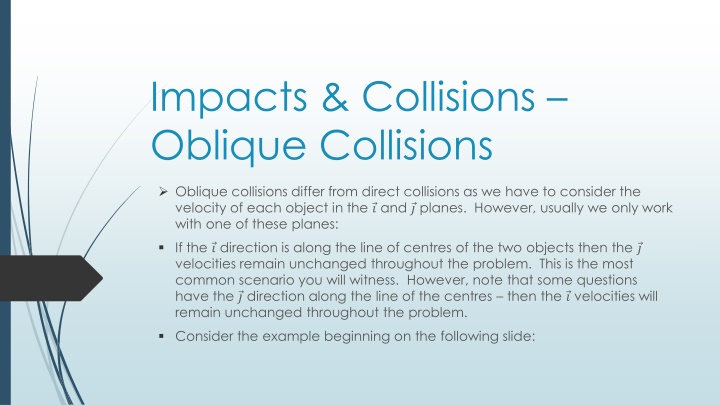
Oblique Collisions in Physics: Understanding Velocity Changes
Explore how oblique collisions differ from direct collisions in physics by considering the velocity of each object in different planes. Learn how to calculate deflection angles after collisions and solve for velocities using trigonometric approaches.
Download Presentation

Please find below an Image/Link to download the presentation.
The content on the website is provided AS IS for your information and personal use only. It may not be sold, licensed, or shared on other websites without obtaining consent from the author. If you encounter any issues during the download, it is possible that the publisher has removed the file from their server.
You are allowed to download the files provided on this website for personal or commercial use, subject to the condition that they are used lawfully. All files are the property of their respective owners.
The content on the website is provided AS IS for your information and personal use only. It may not be sold, licensed, or shared on other websites without obtaining consent from the author.
E N D
Presentation Transcript
Impacts & Collisions Oblique Collisions Oblique collisions differ from direct collisions as we have to consider the velocity of each object in the ? and ? planes. However, usually we only work with one of these planes: If the ? direction is along the line of centres of the two objects then the ? velocities remain unchanged throughout the problem. This is the most common scenario you will witness. However, note that some questions have the ? direction along the line of the centres then the ? velocities will remain unchanged throughout the problem. Consider the example beginning on the following slide:
A smooth sphere ?, of mass ?, is moving with speed ? when it collides with sphere ?, of mass 2?, which is at rest. The direction of motion of ? makes an angle ? with the line of centres at impact. If ? =1 ?, where: ???? = i. 3, show that as a result of the collision sphere ? is deflected by angle 8???? 1+9???2?
We should assume the velocity of ? before collision to be: ????? ? + ????? ?. As the ? velocity does not change throughout the problem, the velocity of ? after collision can be represented by: ? ? + uSin ?. ? begins the problem at rest, so it has an initial velocity of 0 ? + 0 ?, whilst after collision we can consider it to have a velocity of ? ? + 0 ?. We should apply PCM and NELR in the ? direction only, as there is no change in velocity in the ? direction: PCM: ?????? + 2? 0 = ?? + 2?? we can rearrange this to find an expression for both ? and ?: ????? 2? = ? and ????? ? 2 = ? ? ? NELR: ? = 0 ????? ..which gives ?????? = ? ? It is important to recognise that we are not asked to find the velocity of sphere ? after the collision the question only refers to sphere ?. Therefore, we will not waste any time solving for ?. Instead, we will use our expression for ? to allow us to solve for ?:
?????? =????? ? ? 2 2?????? = ????? ? 2? 3? = ????? 2?????? 3? ?????(1 2?) ? =?????(1 2?) 3 1 3) ?????(1 2 As ? =1 2: ? = ?????(1 2 3 3) ? = 3 ?????(1 3) ? = ? =????? 3 9 This means the velocity of sphere ? after collision is given by: ????? ? + ????? ?. 9
One can find the deflection angle, ?, in a number of ways, but here we will use a trigonometric approach. ? is found by subtracting the angle of motion before collision (?) by the angle of motion after collision which we will call ?. We can find ???? by taking so here ???? = ????? 9 ?? ??, ????? . ???? =9???? ???? ???? = 9???? As ???? = ???(? ?), we can use the compound angle formula to give us: ???? ???? 1 ???????? .and filling in for ???? we get: ???? = 9???? ???? 1 + 9????(????) ???? = 8???? 1 + 9???2? ???? =
Note there are many different question types that can be asked within an oblique collisions context this is just one. As with all areas, you should study and practise as many worked examples as you can from your class notes, your textbook and from past exam papers/marking schemes. A good example of a collision which occurs with the ? direction being along the line of centres occurred in 2009 Q5 (b) which can be accessed here: www.examinations.ie/archive/exampapers/2009/LC020ALP000EV.pdf www.examinations.ie/archive/exampapers/2009/LC020ALP000EV.pdf
